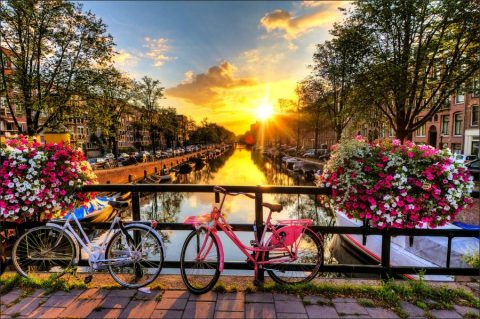The planned regional and international transport and communications system is, along with Amsterdam, one of the best in Europe. As I stepped out of the airport bus, on my very first trip to Amsterdam, I expected to see a rather sleepy city, populated by plump, red-cheeked people who spent their time strolling along quaint canals.
What a surprise I had in store! In no more than a few hours, I had passed restaurant after restaurant where dark-skinned, turbaned waiters were serving exotic dishes of the East Indies to residents and tourists alike.
I had walked through a massive amusement area-the famous “Rembrandtsplein”-where literally scores of cafes and cabarets were offering the kind of entertainment you expect to find only in Paris -but available here for one-third the price!
I had sat at sidewalk cafes in the student section where bearded young scholars were arguing the merits of pop art and new wave films.
I had seen the shops of chic couturiers standing side-by-side with open-air herring stands, at which lovely Dutch girls, in modern bouffant hairdos, were dipping chunks of raw fish into bowls of chopped-up onions and chomping away!
I had quaffed beer in a cafe on the 13th floor of a futuristic skyscraper overlooking the port of Amsterdam, and then descended in an elevator to an area, several square miles in size, where scarcely a building had changed since the 17th and 18th Centuries!
Amsterdam-as you’ve undoubtedly grasped from the above exposition-is a city of fantastic surprises, a place crammed with sights and activities that seem to bear not the slightest resemblance to the picture of tulips, cheese, and wooden shoes that most visitors expect to find.
That’s not to say, of course, that the famed quaintness of Amsterdam doesn’t still exist. There will be times when you round a corner to come upon one of the city’s 50 canals, and to view one of its 500 bridges, and as you gaze upon the vista of quiet waters that flow between an unbroken line of trees and gabled old mansions, you will catch your breath at the sheer beauty of it all. And indeed, the massive central section of Amsterdam, whose architecture has been maintained unaltered for centuries, has been called “the largest open-air museum in the world.”
But the predominant impression of Amsterdam is that of an active, throbbing, cosmopolitan city. It is, of course, one of the chief trading ports on the continent, to which dozens of ships each month, from Indonesia, Dutch Guiana and other exotic lands, wend their way, through the North Sea Canal and then into the harbor at the heart of the city. These, together with all of the trains and planes that every day pour into Amsterdam, in staggering numbers, make it a true crossroads city-a Europe in miniature-and therefore an unbelievably exciting place.
Hits: 165
